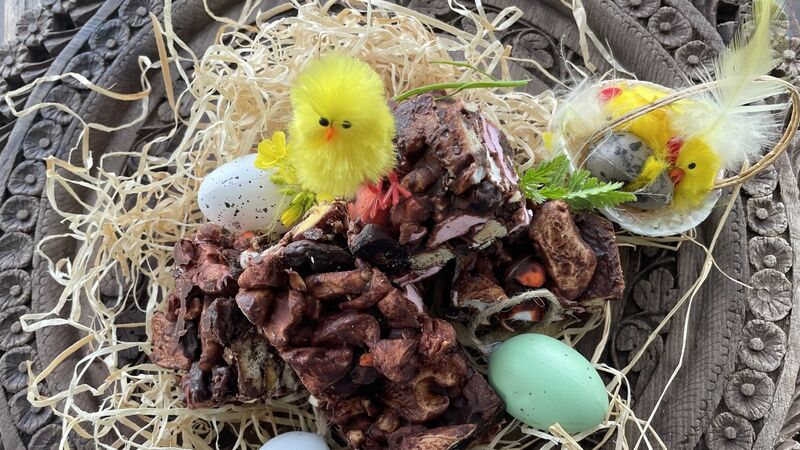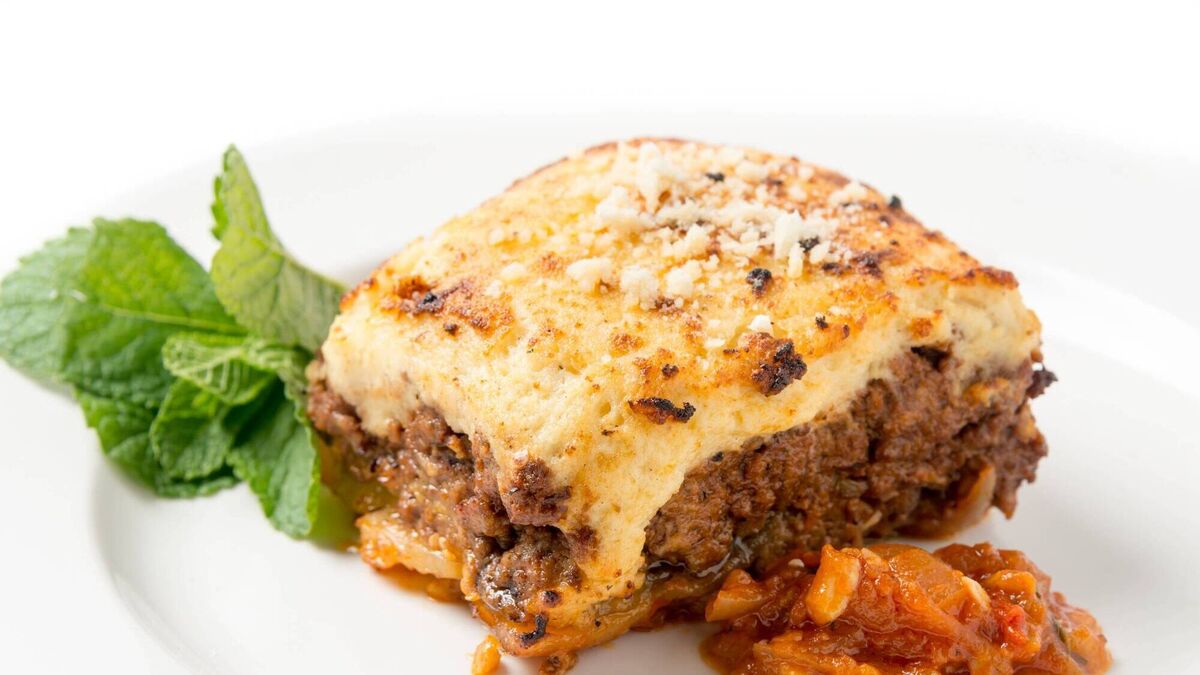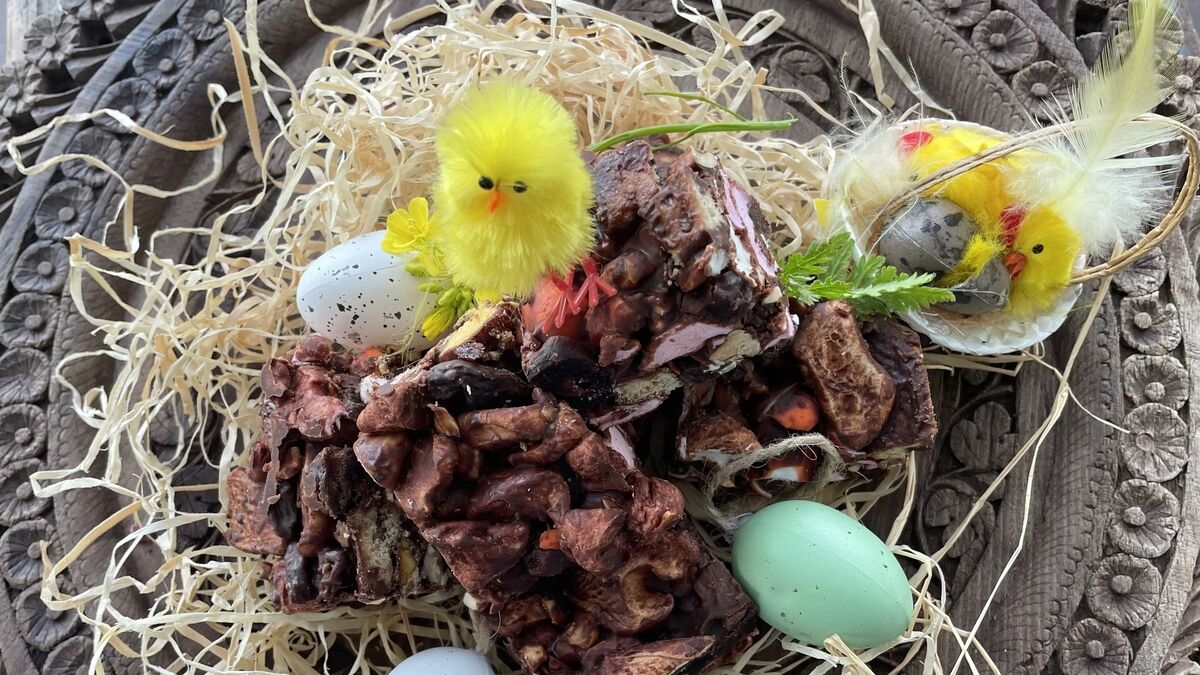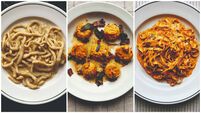Darina Allen: My After Easter Rocky Road is an inspired way to use up leftovers

This recipe is not set in stone - use whatever leftover Easter chocolate you have to hand.
Happy Easter to you all.
I hope you are having a joyful holiday with all your family and friends. If you have children around the house, there will probably be Easter eggs everywhere. I have to say, I’m nostalgic for the days when I nibbled my one precious Easter egg slowly, enjoying every little morsel over several days. I even kept the packaging and smoothed out the shiny, silver foil carefully with my fingers to bring into school to make a collage at art class. Can you imagine…
Well, I’m going to dedicate this week’s column to using up leftovers from the Easter feast. Spring lamb is delicious cold, provided it’s not refrigerated, I just cover the entire dish carefully with a tea-towel and keep it in a cool place. My favourite way to enjoy morsels of leftover lamb is in white bread sandwiches with lots of butter, thinly sliced lamb, a few crisp slices of cucumber, a slick of apple and mint jelly and a few little flakes of sea salt — a delicious combination. We use the handmade Family Pan we make in the Ballymaloe Bread Shed which tastes like a pan loaf used to taste like before the Chorley Wood method for bakeries became the norm.
If you have more cold lamb, how about making a nice, big dish of my Moussaka for tomorrow’s supper. Season it up well and use lots of chopped marjoram or oregano. It reheats and freezes brilliantly and if anything, it even improves. The only accompaniment needed is a green salad of Spring leaves and soft herbs.
Now how about all that chocolate. Collect up all the bits of Easter egg: there are lots of ways to use up all those morsels. Add them to scones or muffins as you might chocolate chips. Alternatively, melt them in cream to make a chocolate ganache, which can be slathered over a chocolate cake, drizzled over vanilla ice-cream or whipped up into a Rum or Grand Marnier-laced mousse. It may also work well when melted or grated into your favourite chocolate cake but do reduce the sugar in the recipe because most Easter eggs are made from inexpensive chocolate that tends to be super sweet.
It’s also fun to make an Easter rocky road by adding a terrifying, combination of mini marshmallows, coarsely chopped speckled eggs, broken digestive biscuits and some Crunchie or honeycomb. I love to add a few raisins and some whole, toasted nuts to the melted chocolate — a little freshly-chopped mint adds extra zing and cuts the sweetness somewhat.
Leftover hot cross buns made a totally delicious bread and butter pudding. Chop up frozen hot cross buns into chunks and add to chocolate chip cookies for a brilliant riff on the original.
Some chopped chocolate can be added to that too or you could pop a hot cross bun back into the oven to reheat, split it in half, add a dollop of chocolate ganache and a scoop of vanilla bean ice-cream or just a dollop of Jersey cream — a decadent treat with the extra feel-good factor of using up leftovers deliciously.
Greek Moussaka
This Greek peasant recipe, served in almost every taverna in Greece is one of the best ways to use up leftover lamb. There are many variations on the theme, some include a layer of cooked potato slices and raisins. I’m sure it’s not my imagination, but I

Servings
8Preparation Time
20 minsCooking Time
60 minsTotal Time
1 hours 20 minsCourse
MainCuisine
GreekIngredients
350g (12oz) aubergines
350g (12oz) courgettes
1 x 400g (14oz) tin tomatoes (use at this time of year) but very ripe fresh tomatoes are best in summer
1 tbsp olive oil plus extra for frying
1 onion, finely chopped (include some green part of spring onion if you have it)
1 large garlic clove, crushed
450g (1lb) cooked minced lamb
1 tbsp chopped fresh marjoram or thyme
2 tsp chopped fresh parsley
1 bay leaf
pinch of grated nutmeg
2 tsp plain white flour
salt and freshly ground pepper
50g (2oz) raisins, plumped up in hot water while you prepare the other ingredients (optional)
For the topping:
45g (1 ½ oz) butter
45g (1 ½ oz) plain white flour
600ml (1 pint) whole milk
1 bay leaf
2 egg yolks
2 tbsp cream
110g (4oz) grated Gruyère or mature Cheddar cheese or a mixture
salt and freshly-ground pepper
Method
Slice the aubergines and courgettes into 1cm (½ inch) slices, score the flesh lightly with a sharp tip of a knife, sprinkle with salt. Leave for half an hour. Roughly chop the tinned tomatoes. Peel and chop the fresh tomatoes finely, if using. Keep the juices.
Heat a tablespoon of olive oil in a heavy saucepan over a gentle heat, add the onions and garlic and cover and sweat for 4 minutes. Add the meat, herbs, bay leaf and nutmeg to the onions. Stir in the flour, cook for 1 minute then pour in the tomatoes and their juice. Bring to the boil, stirring, and simmer for 2-3 minutes. Season well.
Dab the aubergines dry with kitchen paper. Heat a pan-grill over a fairly high heat. Brush both sides of the aubergines generously with extra virgin olive oil, cook until richly coloured on each side. Brush both sides of the courgettes with olive oil, pan-grill until richly coloured on each side. As the courgettes are ready, transfer into the bottom of a shallow casserole. Tip the meat mixture onto the courgettes, sprinkle with the drained raisins if using, then lay the fried aubergines on top. See that the top is as flat as possible.
Preheat the oven to 180˚C/350˚F/Gas Mark 4.
Melt the butter in a saucepan. Stir in the flour. Cook, stirring for 1 minute, then draw off the heat, add the milk slowly, whisking out the lumps as you go. Add the bay leaf. Return the pan to the heat and stir until boiling. Season with salt and pepper and simmer for 2 minutes until thickened. Whisk the egg yolk with the cream in a medium-sized bowl. Pour the sauce on to this mixture whisking all the time. Add half the cheese and pour over the aubergines in the casserole. Sprinkle the rest of the cheese on top and bake for 30-35 minutes in the preheated oven until completely reheated and nicely browned on top. Serve with a good green salad.
Moussaka can be made up in large quantities ahead of time, cooled quickly and frozen after it has been closely covered with parchment paper.
Note: In Autumn, if using fresh tomatoes at the end of the season, it may be necessary to use about 65ml (2 ½ fl oz) of stock to make the mince juicy enough.
Slow roast shoulder of spring lamb with wild garlic aioli and fresh mint chutney
When wild garlic is not in season, double the quantity of parsley, it will still be delicious

Servings
10Preparation Time
20 minsCooking Time
3 hours 0 minsTotal Time
3 hours 20 minsCourse
MainCuisine
IrishIngredients
1 whole shoulder of spring lamb on the bone, weighing approximately 3.6kg (8lb)
Maldon sea salt and freshly-ground pepper
For the aioli:
Homemade mayo or good quality mayonnaise
1-4 cloves of garlic, depending on size
2 teaspoons chopped parsley
2 teaspoons chopped wild garlic leaves (Allium ursinum)
4 -6 tablespoons lamb cooking juices
For the chutney:
1 large cooking apple (we use Grenadier or Bramley Seedling), peeled and cored
a large handful of fresh mint leaves, Spearmint or Bowles mint
50g (2oz) onions
20-50g (1-2oz) castor sugar (depending on tartness of apple)
salt and cayenne pepper
Method
Preheat the oven to 180°C/350°F/Gas Mark 4.
Place the lamb shoulder in a wide roasting tin or oven tray with the skin side up. Score the skin to encourage the fat to run out during the cooking and to crisp up the skin. Season with sea salt and freshly cracked pepper. Place in a roasting tin, transfer to the oven and roast for 30 minutes before turning the temperature down to 160°C/325F/Gas Mark 3 for a further 2 ½ to 3 hours or until the meat is soft and succulent and will lift off the bones.
Mix the crushed garlic into the mayonnaise for the aioli. Finally add the chopped parsley and wild garlic. Taste for seasoning and correct if necessary.
Next make the fresh mint chutney. Whizz all the ingredients in a food processor, season with salt and a little cayenne pepper. Cover and keep cool.
To test if the lamb is cooked to a melting tenderness, pull the shank bone and it and some of the meat should come away easily from the bone.
When the lamb is cooked, remove from the oven. There will be plenty of fatty cooking juices. Strain these through a sieve into a bowl. Keep the lamb warm in the oven with the temperature reduced to 100°C/200°F/Gas Mark ¼.
When the fat has risen to the surface of the lamb cooking juices, skim carefully and thoroughly with a spoon.
Thin out the garlic mayonnaise with 4-6 tablespoons of the degreased juice to achieve a consistency similar to softly whipped cream or in other words the mayonnaise should now just lightly coat the back of a spoon. Taste and correct the seasoning.
Bring the remaining juices to a simmer and taste and correct seasoning.
To serve the lamb, a tongs or serving fork and spoon are the best implements to remove the meat from the bones. Prise largish pieces off the bones and serve on hot plates with some of the hot cooking juices, aoili and the chutney drizzled over the top…
After Easter Rocky Road
An inspired way to use up leftovers! This recipe is not carved in stone so use what you have access to.

Servings
12Preparation Time
2 hours 10 minsTotal Time
2 hours 10 minsCourse
BakingCuisine
IrishIngredients
125g (4 ½ oz) unsalted butter
300g (10oz) chocolate
300g (10oz) mini marshmallows
110g (4oz) cherries, cut in half or a mixture of cherries and Crunchie
110g (4oz) raisins
110g (4oz) hazelnuts (toasted and skinned)
110g (4oz) biscuits, chopped or broken
150g (5oz) mini speckled eggs – leave 75g (3oz) whole and cut the remaining in halves.
23cm (9 inch) square tin (5cm/2 inch depth) lined with silicone paper
Method
Melt the butter and chocolate gently in a Pyrex bowl sitting over a saucepan of tepid water, allow to cool but while still liquid stir in the marshmallow, halved cherries, Crunchies (if using), raisins, hazelnuts, biscuits and mini speckled eggs. Toss gently to coat in the melted chocolate. Pour into a lined tin and allow to set for 2 hours or over overnight.
Cut into squares or whatever you fancy.
The award-winning Food On The Edge is scheduled to take place in Airfield Estate, Dundrum in Dublin on October 17 and 18, 2022. Book now.
The Theme is Disruption and Regeneration. There’s quite a line-up already: confirmed speakers to date include 30-year-old Rasmus Monk, of Copenhagen’s Alchemist Restaurant, recently named as OAD’s Best Restaurant in Europe 2021; Paolo Casagrande of Barcelona’s 3 Michelin star Lasarte; Calum Franklin ‘the pie king’ who heads up the popular The Pie Room in the Holborn Dining Room in London; and Søren Ørbek Ledet co-owner and sommelier of 3 Michelin-star Geranium , Denmark. Making a welcome return to Food on the Edge are authors, chefs and activists: food-educator Alice Zaslavsky; Jess Murphy of Kai Galway; social gastronomy disruptor, Joshna Maharaj; and thought-leader on food and cities, Carolyn Steel . Simon Rogan of L’Enclume will make his Food On The debut while Matt Orlando, of Copenhagen’s Amass and a Food On The Edge veteran, will also return. Early Bird tickets are on sale now: €250 for two days including lunch on both days.
Was there ever a more timely opportunity to learn how to identify the delicious and nutritious foods that grow wild all around us and not just in the countryside but also in urban areas. In just a couple of hours, learn to spot 40-50 different plants and how to incorporate them into your family meals. Booking essential, limited numbers.
Rare and precious seakale is now in season. The only seasonal vegetable that can only be found for just 3 or 4 weeks. Check out Midleton Farmers’ Market, Cork English Market or the Ballymaloe Cookery School Farm Shop. Telephone ahead, 021 4646785






